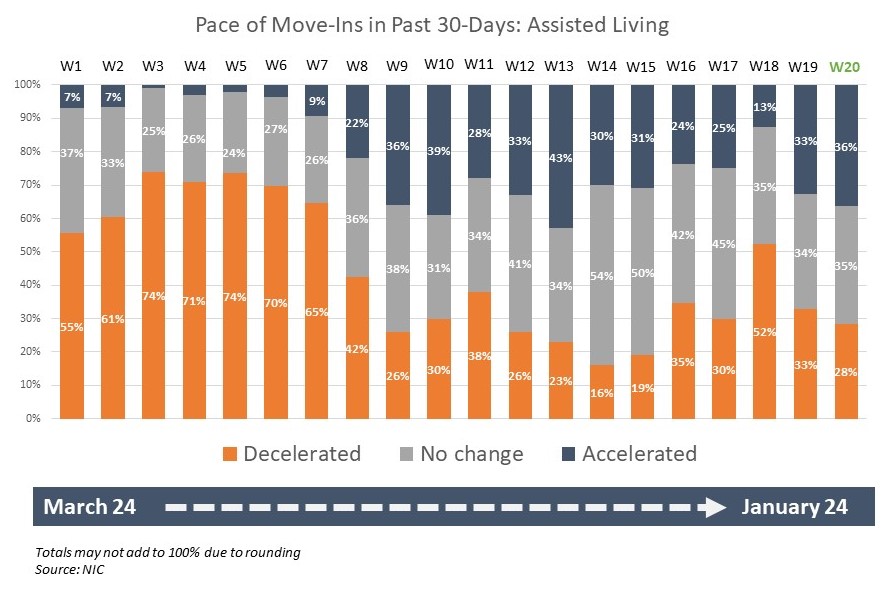As we enter a new year, NIC’s Executive Survey Insights is, at the time of this writing, entering it’s twenty-first ‘wave,’ the results of which will be posted right here, on February 11. The report for Wave 20 just posted here on NIC Notes this week. Looking back, it’s possible to see just how closely the survey’s results have mirrored the reality experienced by so many across the industry, and to appreciate the value of this unique tool, as leaders focus anew on navigating an uncertain future.
Readers of this blog, the NIC Insider, and numerous media outlets, along with attendees of the 2020 NIC Fall Conference, who can review sessions here, may by now be familiar with NIC’s Executive Survey Insights data updates. Launched in mid-March 2020, as part of a broader effort to provide timely insights on the impact of the COVID-19 pandemic across the seniors housing and care industry, the survey’s bi-weekly data releases, accompanied with detailed analysis from NIC Senior Principal Lana Peck, have become closely watched.
With over 2,000 completed surveys to date, yielding data on properties of every size, type, ownership structure, and across each care segment in the industry, this series of surveys now averages over 80 completions every two weeks. Each completed survey provides data from the perspective of an owner/operator’s entire portfolio of seniors housing and care properties. The result is a cross-section of America’s seniors housing and care industry, updated almost in real-time. A further result is that, amidst an onslaught of media attention, much of which is negative, the survey provides a reality-based measure of what’s actually happening across the sector.
Peck’s blog posts, releasing new waves of Executive Survey Insights data, garner thousands of readers within hours of publication. In fact, several of these posts rank among NIC’s most-read for all of 2020. For many industry watchers and analysts, it is likely that each wave of survey results provides helpful tools for interpretation, particularly as it precedes sources of hard data by weeks and months.
Analysts are not the only ones carefully studying Peck’s blog posts. Frequently, survey results and analysis are referenced in media reports on the sector. Readers of McKnight’s publications, Mortgage Professional America Magazine, Senior Housing News, Multi-Housing News, and other industry-watching media outlets may have noticed a regular flow of stories that are based on the latest Executive Survey Insights findings. The surveys’ findings have also been mentioned in stories by Kaiser Health News, CNN, the Wall Street Journal, and other major news outlets across the U.S.
Industry leaders, and those who are watching the industry, have found the survey to be a consistent indicator of trends, worthy of careful consideration as they plan their strategies going into the new year. Looking at the patterns in the data, which is collected, carefully checked for quality and consistency, analyzed, then released far closer to real-time than traditional sources of hard data, it is possible to discern how the pandemic has impacted various sectors within seniors housing and care, and continues to do so.
A look at the time series data over the 20 waves of survey results, reveals just how accurate the survey is in reflecting trends. The graph below shows the drastic slowdown in move ins to assisted living early in the pandemic, followed by a pickup over the summer and a tapering off as conditions worsened in the fall.

Access to the Executive Survey Insights full time series graphs, showing occupancy and more over the 20 waves of the survey, is available here.
As Peck said during the “Insights from NIC’s Executive Survey” session she presented at the 2020 NIC Fall Conference in October, “This is the longest-running survey of operators since the start of the pandemic.” That was back in October, covering the first 11 waves of data. Peck pointed out that the survey is also the most frequently updated source of insight on the sector and tracks more closely to real-time than other data sources. In the Fall Conference session, Peck said, “These near-real-time insights on the effects of the pandemic on senior living are working to help ensure the narrative on the sector is accurate in an environment of headline sensationalism,” before diving into an analysis of the survey’s findings up to that point in time.
The survey collects executives’ comments, as well as their hard data. Through those comments, Peck’s analysis often includes a connection to the real-world experiences and concerns that leaders across the industry are reporting, as they face daily struggles to acquire sufficient PPE, testing, staffing resources, and now vaccines. A review of that commentary lead to the publication of another most-read blog post, “We Feel We Are Alone In A War-Zone.” The post, which was published after only two waves of the survey, nevertheless offers a wealth of insight into the daily struggles and challenges faced by industry leaders fighting every day on the front-lines of a historic battle to save lives, and helped bring attention to their most pressing needs at the time.
With regular emails and a recent direct-mail initiative, NIC continues to actively encourage executives in all types of senior living organizations to participate every two weeks. It takes about 5-10 minutes to complete the survey, which includes questions related to changes in occupancy and move-in/move-out rates, availability of PPE, COVID-19 testing, staffing, and most recently, vaccines and vaccination rates. Their continued participation, during a time of such stress and urgency, is perhaps the greatest testament to the value of the ongoing initiative.
To stay up-to-date on the latest findings of the Executive Survey Insights, subscribe to NIC Notes. To participate in the survey, owner/operator executives (one per company) can provide data, by completing the survey regularly. A sneak peek of the results is shared with survey participants on Wednesday evenings with public release Thursday mornings. For the hundreds of senior executives who continue to participate, NIC, and thousands of stakeholders, sincerely thank you for your time and your transparency.